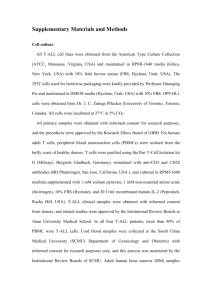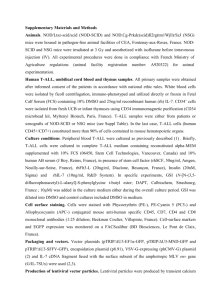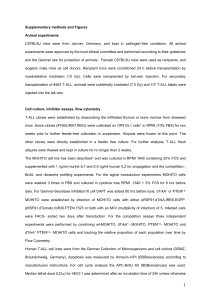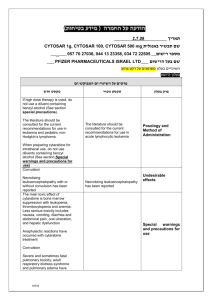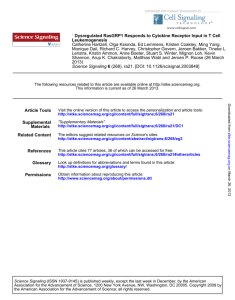Supplementary Information (doc 104K)
advertisement
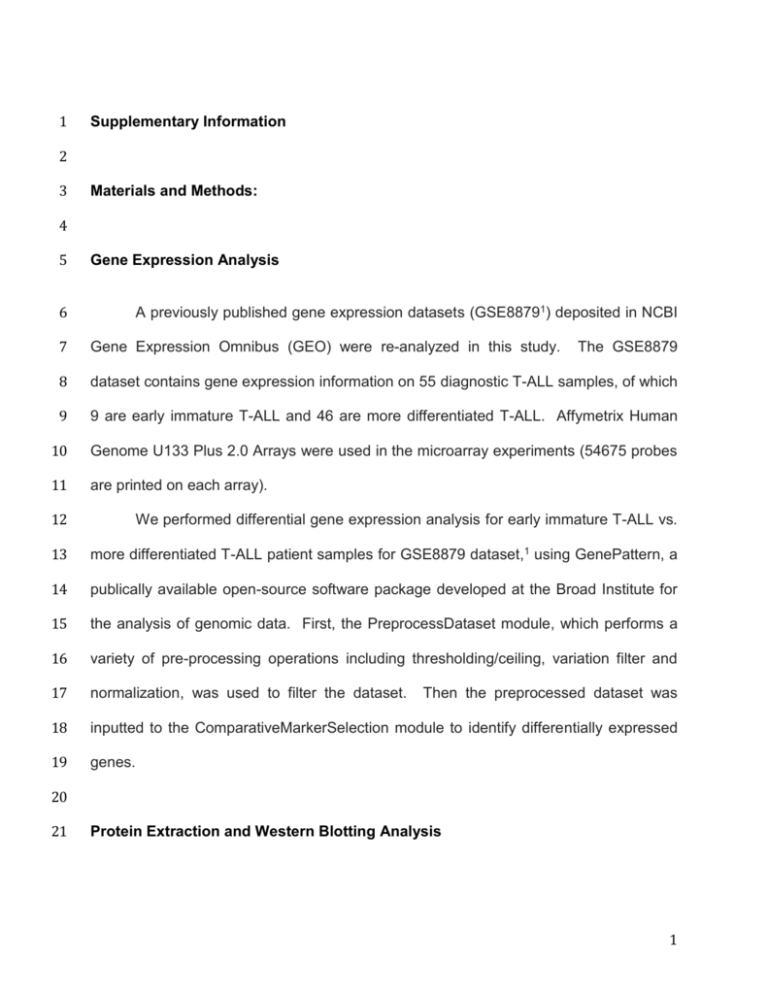
1 Supplementary Information 2 3 Materials and Methods: 4 5 6 Gene Expression Analysis A previously published gene expression datasets (GSE88791) deposited in NCBI 7 Gene Expression Omnibus (GEO) were re-analyzed in this study. 8 dataset contains gene expression information on 55 diagnostic T-ALL samples, of which 9 9 are early immature T-ALL and 46 are more differentiated T-ALL. Affymetrix Human 10 Genome U133 Plus 2.0 Arrays were used in the microarray experiments (54675 probes 11 are printed on each array). The GSE8879 12 We performed differential gene expression analysis for early immature T-ALL vs. 13 more differentiated T-ALL patient samples for GSE8879 dataset,1 using GenePattern, a 14 publically available open-source software package developed at the Broad Institute for 15 the analysis of genomic data. First, the PreprocessDataset module, which performs a 16 variety of pre-processing operations including thresholding/ceiling, variation filter and 17 normalization, was used to filter the dataset. 18 inputted to the ComparativeMarkerSelection module to identify differentially expressed 19 genes. Then the preprocessed dataset was 20 21 Protein Extraction and Western Blotting Analysis 1 22 Whole cell lysates were prepared in RIPA buffer for the following T-ALL cell lines: 23 LOUCY, ALL-SIL, CCRF-CEM, HSB2, SUPT-11, SKW-3/KE-37, MOLT4, JURKAT and 24 JURKAT overexpressing BCL2 and luciferase. The primary antibodies included: anti- 25 BCL2 (Santa Crutz, Dallas, TX, USA), anti-BCL-XL (Cell Signaling, Boston, MA, USA), 26 anti-BCLw (Abcam, Cambridge, MA, USA) and anti-ACTIN (Sigma, St. Louis, MO, USA) 27 antibodies. 28 mouse or anti-rabbit antibodies (Thermo, Rockford, IL, USA). Autoradiographs were 29 imaged with a LAS-3000 imaging system (Fuji, Tokyo, Japan) and a CCD camera. All 30 images were prepared for publication with Adobe Photoshop (Adobe, San Jose, CA, 31 USA) software. Secondary antibodies included horseradish peroxidase-conjugated anti- 32 33 34 Cell Lines and Cell Viability Assay Cell lines were cultured in RPMI1640 (Corning, Corning, NY, USA) 35 supplemented with 10% fetal bovine serum (Life Technology, Carlsbad, CA, USA). For 36 viability assay cells were plated at a density of 20,000 per well in a 96 well plate 37 (Corning, Corning, NY, USA) and incubated for indicated times in DMSO (ATCC, 38 Manassas, VA, USA), ABT-199 (Chemietek, Indianapolis, IN, USA), ABT-263 39 (selleckchem), cytarabine (Sigma, St. Louis, MO, USA), doxorubicin (Pfizer, New York 40 City, NY, USA), etoposide (Accord Healthcare, Durham, NC, USA), dexamethasone 41 (Sigma, St. Louis, MO, USA), rapamycin (LC laboratories, Woburn, MA, USA). Cell 42 Titer Blue assay (Promega, Madison, WI, USA) was used to assess cell viability and 43 was reported as a relative percentage versus control cells. 2 44 45 Apoptosis and Cell Cycle Analysis 46 Apoptosis was assessed with Annexin V and propidium iodide (PI) staining, based on 47 two populations: early apoptosis (PI-, Annexin V+) and late apoptosis (PI+, Annexin V+). 48 Specifically, cells were incubated at room temperature for 20 minutes with Annexin V- 49 APC (BD Bioscience, San Jose, CA, USA), PI (50ug/ml) (Sigma, St. Louis, MO, USA) 50 and 1x binding buffer (BD Pharmagen, San Jose, CA, USA). For cell cycle analysis, 51 cells were fixed in ice cold 100% ethanol and incubated at -20oC for 30min. Fixed cells 52 were then 53 incubated for 20 min at 4oC in the dark. Cells stained for apoptosis and cell cycle were 54 analyzed on a FACScalibur (BD Bioscience, San Jose, CA, USA) and data were 55 analyzed with either Flowjo or Modfit software. 56 57 Combinatory Treatment of Small Molecules 58 T-ALL cell lines were treated with a combination of ABT-199 and Cytarabine with a 59 range of doses around the IC50 of each drug alone. Cell viability was analyzed by Cell 60 Titer Blue assay (Promega, Madison, WI, USA). 61 Cambridge, UK) was used to calculate the potency of drug combination and we used 62 the Chuo-Talalay method2 to calculate a combined index (CI). 63 isobolograms were also produced with Calcusyn software. The CI has been interpreted 64 as follows: very strong synergy (<0.1), strong synergy (0.1 to 0.3), synergism (0.3 to Calcusyn software (Biosoft, Normalized 3 65 0.7), moderate synergism (0.7 to 0.85), slight synergism (0.85 to 0.9), nearly additive 66 (0.9 to 1.1), slight antagonism (1.1 to 1.2) and moderate antagonism (1.2 to 1.45). 67 68 69 Statistical Analysis GraphPad Prism software was used to calculate significant values (p) using a 70 two-tailed Student’s t test. 71 statistically significant. P-values less than or equal to 0.05 were considered 72 73 74 Supplementary Figure Legends: 75 76 Supplementary Figure 1. 77 The expression of BCL-XL, MCL-1 and BFL-1 in early immature T-ALL primary 78 patient samples. BCL-XL (probe ID: 215037_s_at), MCL-1 (probe ID: 200796_s_at) 79 and BFL-1 (probe ID: 205681_at) were expressed in early immature T-ALL patients 80 samples at levels similar to more differentiated T-ALL. Data was generated by re- 81 analyzing a published gene expression dataset (GSE8879)1 that contained 9 early 82 immature T-ALL and 46 more differentiated T-ALL patient samples. 83 84 Supplementary Figure 2. 85 ABT-263 and ABT-199 induce apoptosis in LOUCY cell line. The LOUCY cell line 86 was treated for 48h with either ABT-263 (0nM, 30nM and 125nM) or ABT-199 (0nM, 4 87 15nM and 2000nM) and then cells stained with Annexin V and PI. Cells were examined 88 by flow cytometry to determine early apoptosis (PI-, Annexin V+) and late apoptosis (PI+, 89 Annexin V+). 90 91 Supplementary Figure 3. 92 The LOUCY cell line shows resistance to T-ALL induction therapeutics. A panel of 93 eight T-ALL cell lines - LOUCY, ALL-SIL, CCRF-CEM, HSB2, JURKAT, SUPT-11, 94 SKW-3/KE-37 and MOLT4 were treated for 48 hours, with the following T-ALL induction 95 therapeutics: (a) etoposide, (b) dexamethasone, (c) rapamycin, (d) vincristine and (e) 96 doxorubicin. Relative cell viability was measured using Cell Titer Blue reagent. The 97 values represented in the graphs are the means SD, and represent three biological 98 replicates. 99 100 Supplementary Figure 4. 101 Cytarabine induces S-phase cell cycle arrest in LOUCY and JURKAT cell lines. (a- 102 d) Cytarabine alone and in combination with ABT-199 induces S-phase arrest. The 103 histograms represent cell cycle analysis of PI stained cells showing the DNA content of 104 LOUCY cells treated for 24 hours with (a) DMSO (control), (b) ABT-199 15nM, (c) 105 Cytarabine 75nM and (d) both drugs in combination (ABT-199: 15nM; cytarabine: 106 75nM). Values are means SD, and represent three biological replicates. *, P<0.05; **, 107 P<0.001; ***, P<0.0005. 108 5 109 110 Supplementary Figure 5. 111 Cytarabine and ABT-199 synergizes to promote apoptosis in LOUCY cells. 112 Apoptosis analysis was performed on LOUCY cells stained with Annexin V and PI 24 113 hours after treatment. The LOUCY cells were treated with DMSO (control) (far left 114 panel), ABT-199 15nM (middle left panel), cytarabine 75nM (middle right panel) and 115 both drugs in combination (ABT-199: 15nM; cytarabine: 75nM) (far right panel). Values 116 are means SD, and represent three biological replicates. Statistical significance is 117 indicated by: *, P<0.05; **, P<0.001; ***, P<0.0005. 118 119 120 References: 121 1. 122 Early T-cell precursor leukaemia: a subtype of very high-risk acute lymphoblastic 123 leukaemia. Lancet Oncol. 2009;10:147-56. 124 2. 125 Chou-Talalay method. Cancer Research. 2010;70:440-6. Coustan-Smith E, Mullighan CG, Onciu M, Behm FG, Raimondi SC, Pei D, et al.: Chou TC: Drug combination studies and their synergy quantification using the 126 6
